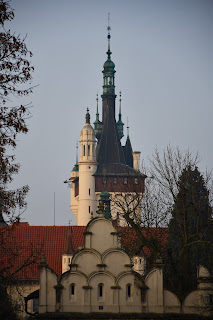Day 3 in Uganda: Following the footsteps of overweight wazungu in Kapchorwa
In an unforeseen turn of events, it was our group and not the hotel that ended up running on “African time” in the morning. I woke up at half past six to eat our seven o’clock breakfast and embark on our seven-thirty tour of the three Sipi Waterfalls. However, a combination of missed alarms and uncompromising attitudes towards eating leisurely breakfasts resulted in a delay of over half an hour.
Our guide
from yesterday took charge of us once more, giving us all walking sticks before
leading us up the narrow muddy paths to the first waterfall. All the way, I
tried to maintain a dignified composure with the stick in one hand, my umbrella
in the other, and my camera swinging wildly from my neck. We must all have made
for quite a spectacle, but all the same we were greeted by a chorus of cheery,
high-pitched hellos wherever we went. It occurred to me that this must have
been one of the demographically youngest areas I have ever visited, and it
really showed in the faces of passersby.
Our guide
Eric began the day with a personal challenge of finding ten chameleons. As the
day progressed and he kept finding more and more, he raised the challenge to
twenty. Embarrassingly, none of us found a single one; we blamed it on being in
the back, but Eric’s eyesight was astoundingly good. He could spot tiny green
chameleons that could fit in the palm of his hand from a distance at which the
rest of us could barely distinguish one leaf from another. He told us that the
ecological service provided by chameleons is highly appreciated by the local
community, as they consume potentially harmful insects on their patrols of the
coffee trees.
The entire
hike took over four hours, the last part being reserved for abseiling. Over a
glass of maize beer, the hotel owner told us the preceding evening of an
overweight white woman who had paid for an abseiling session at the falls: “I
thought this one hundred fifty kilo mzungu was going to die and my hotel would
get shut down.” The woman not only survived but had a great time, yet I
remained unconvinced. As the rest of the group rappelled from the top of the
last giant waterfall, I made a leisurely hike down and waited for them at the
bottom. While I have gotten better at controlling my acrophobia when I am
promised a good view, dangling one hundred metres above the ground on a single
rope did not promise any reward even remotely commensurate with the risk.
We departed
from the hotel around half past one, having been detained by a long,
handwritten settlement of accounts with the manager. Instead of eating lunch at
the hotel, we had it packed and ate it during our three-hour-long ride to
Jinja. Our group also grew from our original four people to five: we picked up
a lady who had hitchhiked all the way to Kapchorwa from Kampala two days
previously, and being the only other visitor at our hotel she quickly
befriended us. She did not mind stopping at Jinja with us and partaking in the
activities we had planned.
Situated on
the banks of Lake Victoria, Jinja acquired special significance in the
nineteenth century, when it was identified as the source of the Nile. Since
then, the town has become one of Uganda’s most popular recreational sites and
tourist attractions. There are a number of campsites and hotels along the lake,
and while people do not often bathe in it, activities like rafting are quite
popular. As for us, we booked an hour-long boat trip with the brother of one of
Victoria’s friends. Although we had only planned to sail to the official Source
of the Nile, we seized at the boatman’s suggestion that we add a birdwatching
component, as Victoria had already been to Jinja multiple times. The richness
of the wildlife made me regret that I had not brought a zoom lens: we saw
several species of kingfishers and herons, as well as cormorants, egrets, an
otter, and a basking monitor lizard.

























Comments
Post a Comment